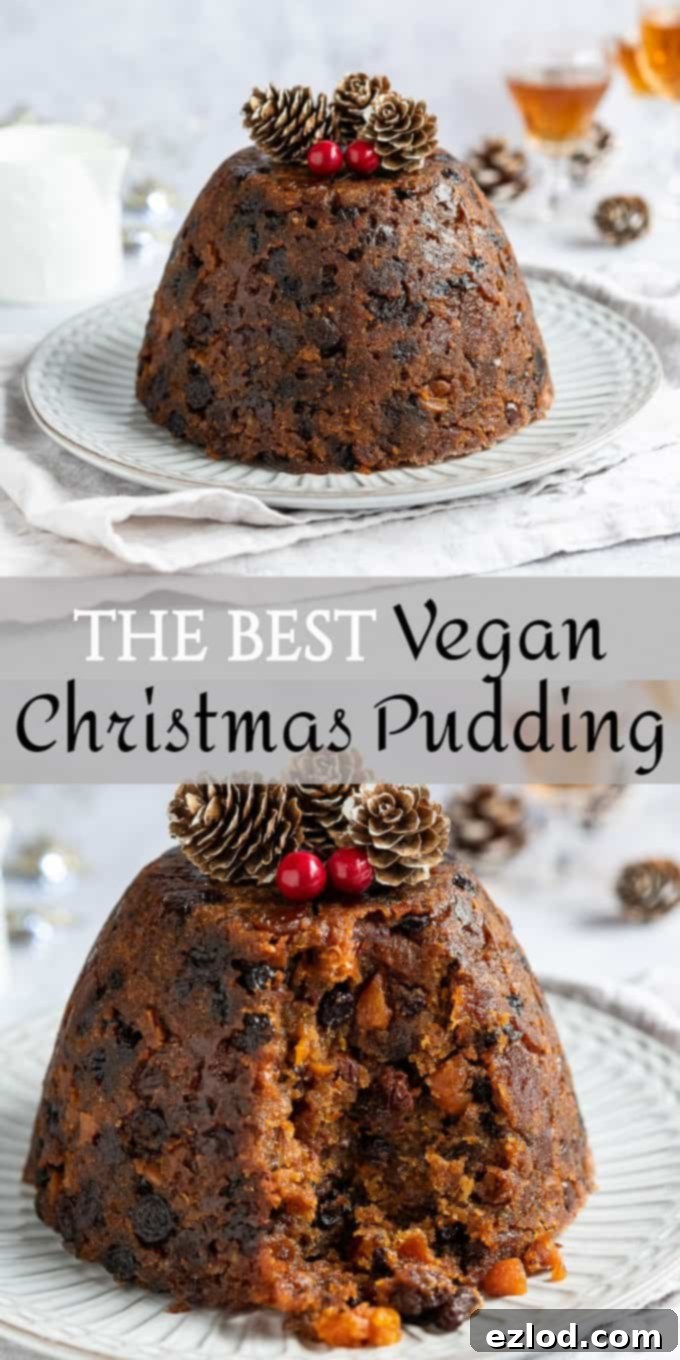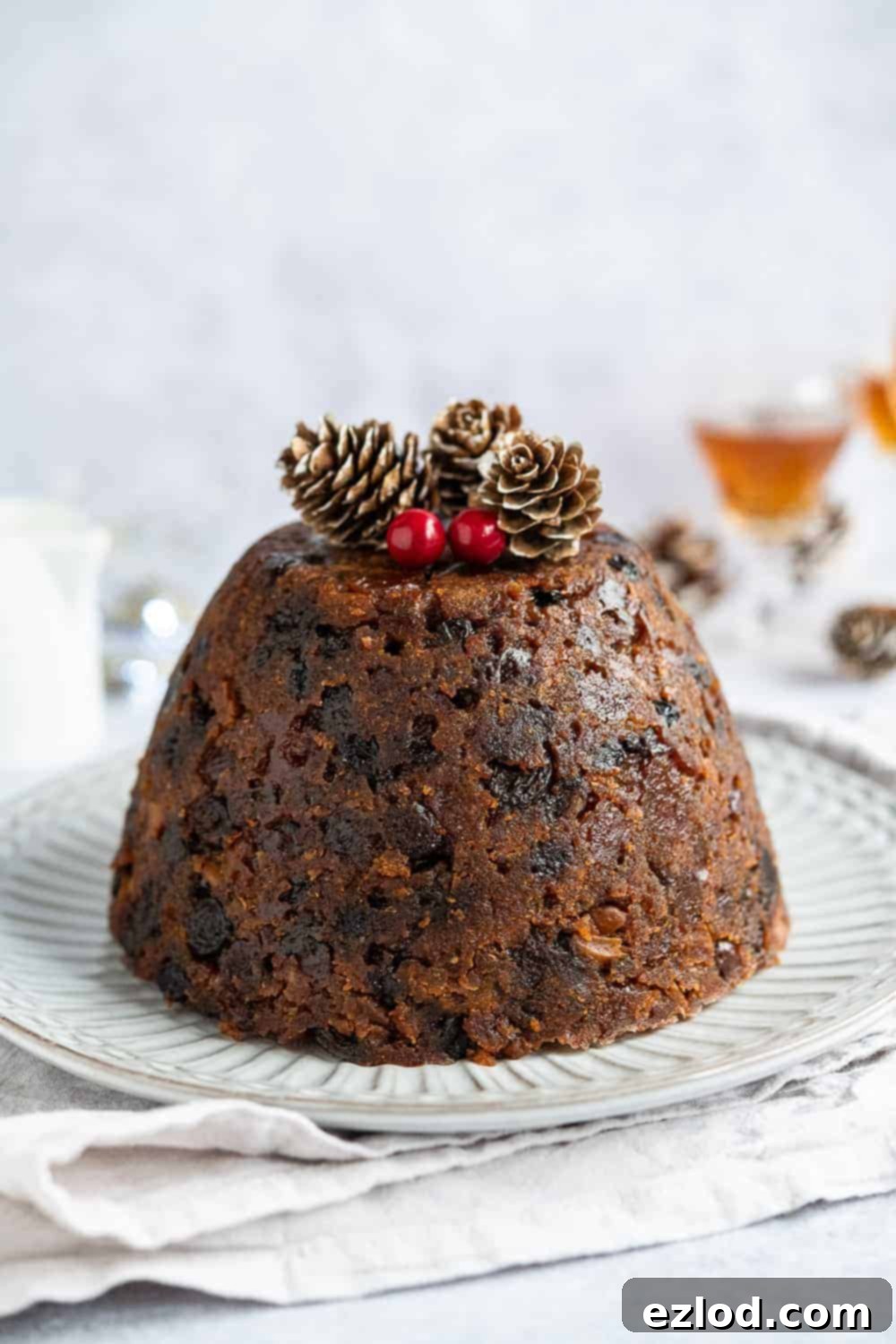The Ultimate Vegan Christmas Pudding Recipe: Rich, Boozy & Effortlessly Festive
Embrace the spirit of a traditional British Christmas with this incredible vegan Christmas pudding. Forget the dense, heavy reputation of classic puddings; this plant-based version is wonderfully rich, delightfully moist, bursting with fruity flavors, and perfectly boozy – yet surprisingly light. It’s an easy-to-follow recipe that offers the flexibility to be prepared months in advance for a deeply matured flavor or enjoyed just a few days after cooking. Whether you’re a seasoned chef or a first-time pudding maker, this guide will help you create a show-stopping festive dessert that will impress everyone at your Christmas table.
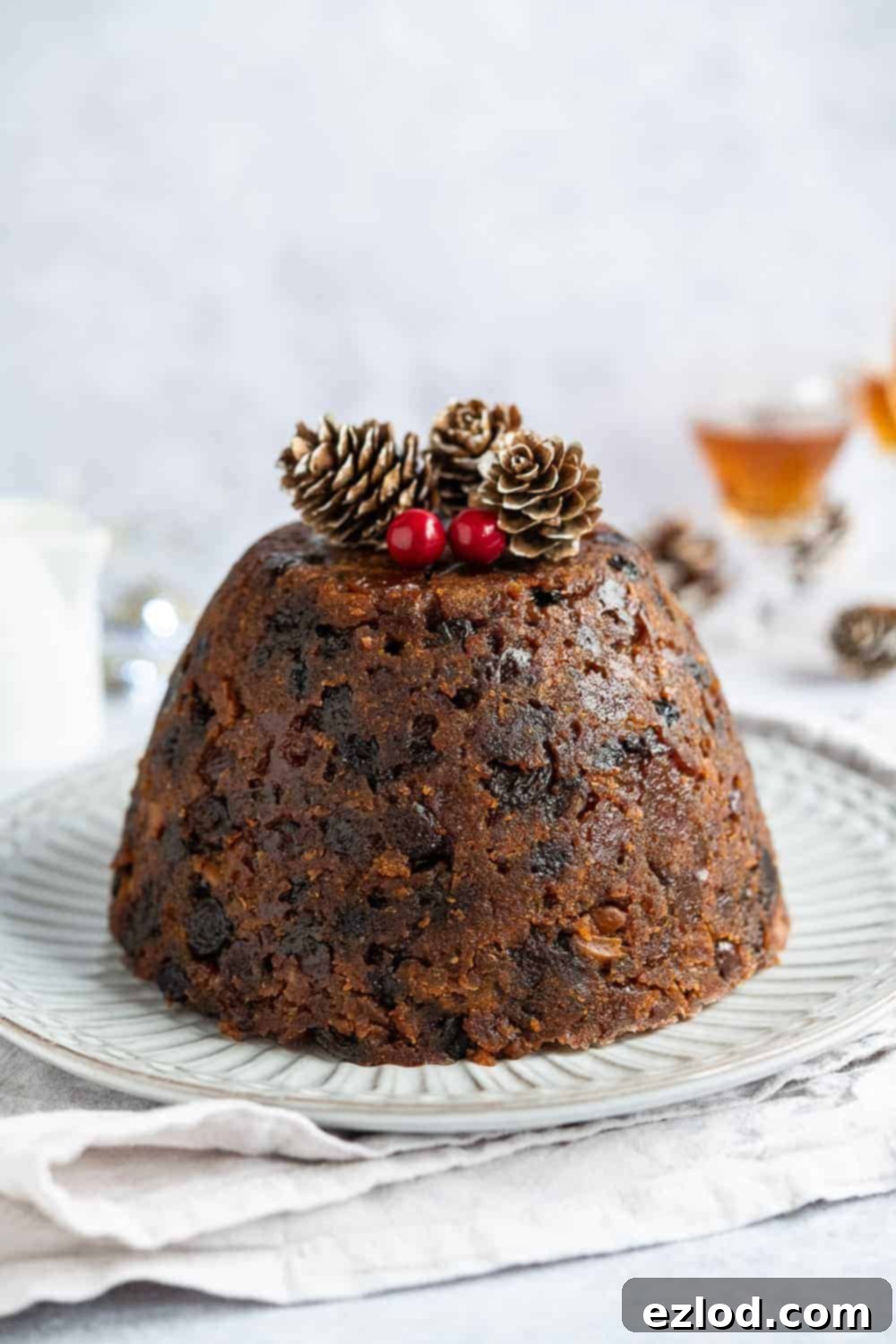
Why Choose a Vegan Christmas Pudding?
Christmas pudding holds a special place in British festive traditions, often evoking strong opinions. While some adore its deep, complex flavors, others find the traditional suet and egg-laden versions a little too heavy or dense. This vegan rendition offers all the beloved characteristics of a classic Christmas pudding – the intoxicating aroma of spices, the succulent rum-soaked dried fruit, and a wonderfully moist texture – without the heaviness. It’s a testament to how incredible plant-based baking can be, proving that a vegan alternative can be just as, if not more, delicious and satisfying than its traditional counterpart.
Our recipe achieves a lighter texture by cleverly replacing animal products with plant-based alternatives like aquafaba and refined coconut oil. This ensures that while it remains a truly indulgent dessert, it won’t leave you feeling overly full after your Christmas dinner feast. It’s the perfect sweet ending, offering a harmonious blend of festive flavors that truly captures the magic of the season.
Is Making Christmas Pudding Difficult?
The idea of making a traditional Christmas pudding can seem daunting, conjuring images of intricate steps and hours of labor. However, the reality is far simpler than you might imagine. While it does require a significant amount of steaming time – typically around five hours – most of this is hands-off. Once assembled and placed in the steamer, the pudding quietly cooks itself, leaving you free to focus on other festive preparations.
The process is more about patience than skill. The initial preparation involves soaking the fruit overnight, followed by a straightforward mixing of ingredients the next day. The lengthy steaming is crucial for developing the pudding’s characteristic rich color, deep flavor, and tender, moist consistency. This recipe is designed to be accessible, guiding you through each stage with clear instructions, making it an enjoyable and rewarding holiday baking project.
The Magic of Maturation: Planning Ahead for Peak Flavor
One of the most cherished traditions of Christmas pudding is its ability to mature. Making your pudding well in advance, often on ‘Stir-Up Sunday’ (the last Sunday before Advent), allows the flavors to deepen and meld, resulting in an even richer and more complex dessert. This vegan Christmas pudding is no exception; it can be made up to six months before Christmas, benefiting immensely from regular ‘feeding’ with brandy or rum during its storage period. The alcohol not only enhances the flavor but also acts as a natural preservative, ensuring your pudding is perfectly moist and intensely flavored come Christmas Day.
Even if you’re short on time, this recipe is flexible enough to be prepared just a couple of days before serving. While it won’t have the same depth of flavor as a fully matured pudding, it will still be incredibly delicious and festive. On the day of serving, a quick re-steaming for an hour or two brings it back to its glorious, steaming best.
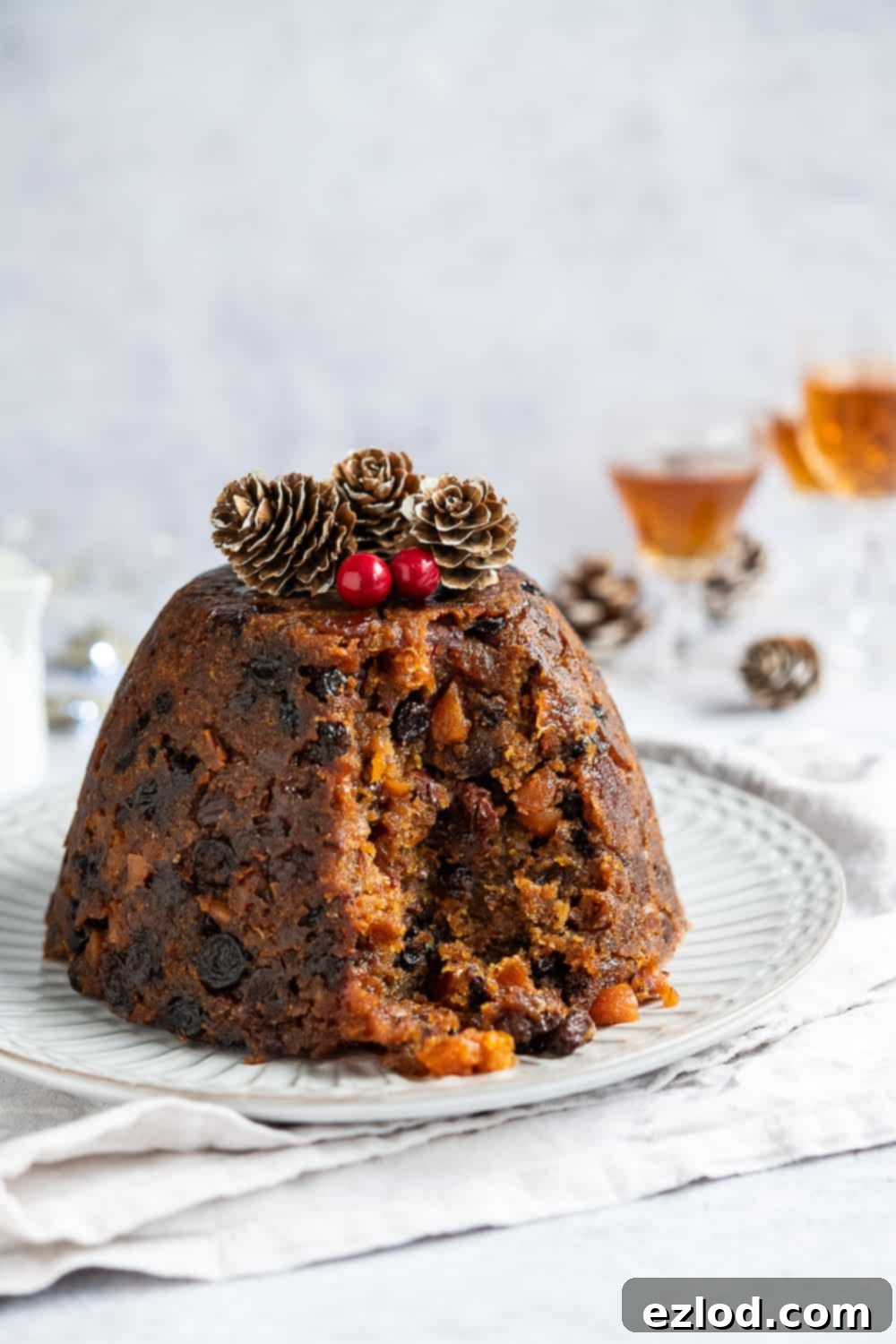
How to Make the Best Vegan Christmas Pudding: A Step-by-Step Guide
Creating this delicious vegan Christmas pudding is a process divided into a few simple stages, primarily soaking, mixing, and steaming. For precise measurements and detailed steps, refer to the full recipe card below. However, here’s an overview and some key insights to help you achieve the best results.
Ingredient Focus: Dried Fruit & Alcohol
The heart of any good Christmas pudding lies in its dried fruit. This recipe calls for a generous mix of raisins, currants, chopped dates, and apricots. Soaking these fruits overnight in a generous splash of brandy, rum, or sherry, along with orange zest and juice, is crucial. This step plumps up the fruit, infuses it with rich flavor, and contributes significantly to the pudding’s moist texture. Don’t skip it! Feel free to customize your fruit selection, ensuring the total weight remains the same. Dried cranberries, cherries, or figs would also be fantastic additions.
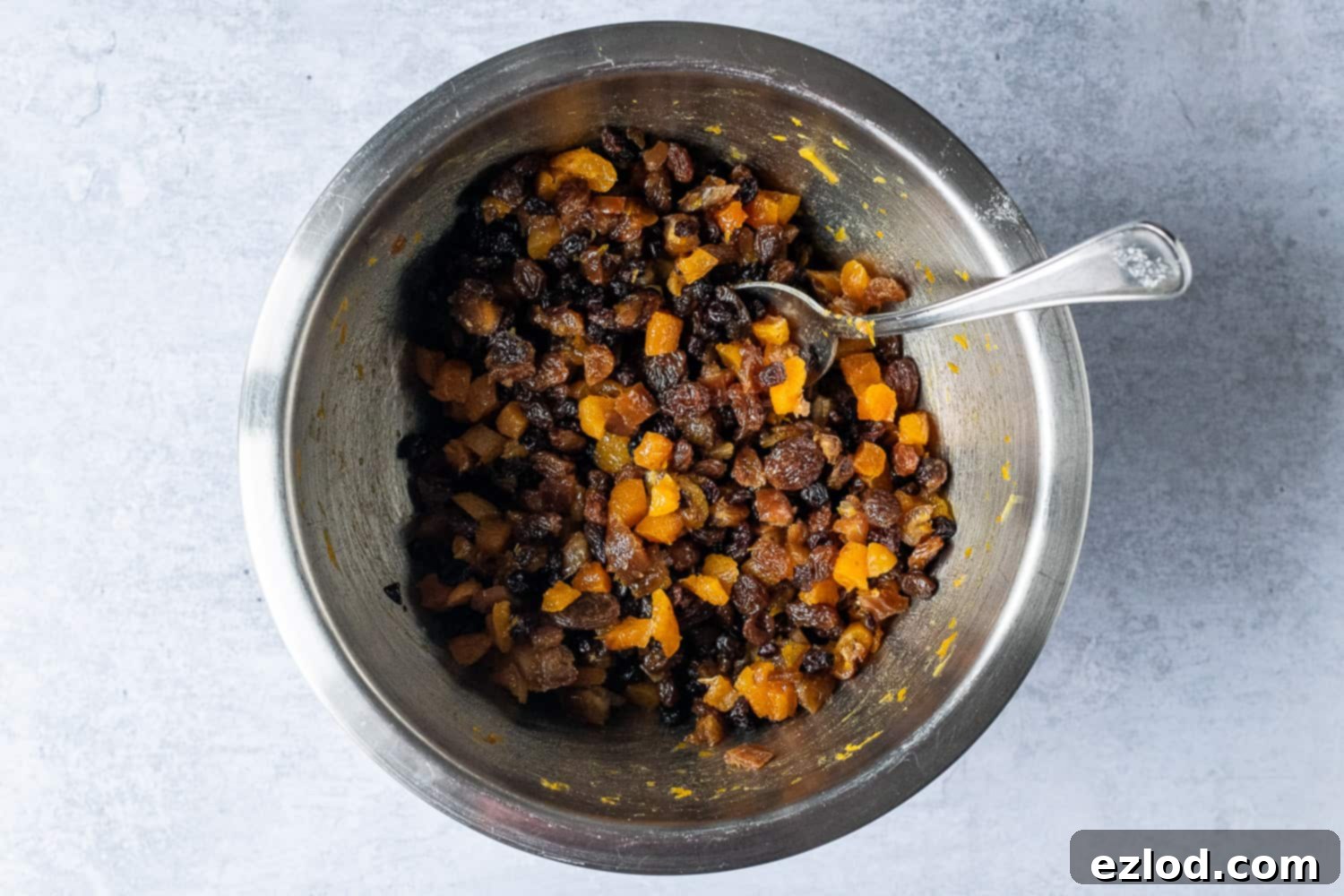
The Vegan Superstars: Aquafaba and Coconut Oil
To replace the eggs and suet/butter found in traditional puddings, this recipe utilizes two fantastic vegan ingredients: aquafaba and refined coconut oil. Aquafaba, the liquid from a can of chickpeas, acts as a superb binder and helps create a lighter texture, mimicking the role of eggs. Refined coconut oil, on the other hand, provides the richness and moisture typically delivered by suet or butter. It’s vital to use *refined* coconut oil, as it has a neutral flavor, ensuring your pudding tastes wonderfully traditional and not like coconut. These two ingredients are truly the best substitutes, and I highly recommend sticking with them for optimal results.
Apples and Breadcrumbs: Essential Texture Builders
A grated cooking apple, such as a Bramley or Granny Smith, adds natural moisture and a touch of tartness that balances the sweetness of the fruit and sugar. Fresh breadcrumbs (made from slightly stale white bread) contribute to the pudding’s unique texture, preventing it from becoming too dense. These elements are key to achieving the perfect pudding consistency.
Mixing the Pudding: Key Steps
Once your fruit has soaked, the rest is straightforward. You’ll stir in the grated apple, followed by self-raising flour, fresh breadcrumbs, light brown soft sugar, and mixed spice (or pumpkin spice for an American twist). Finally, the aquafaba, melted refined coconut oil, non-dairy milk, and optional chopped almonds are incorporated. Mix everything until just combined – overmixing can lead to a tougher pudding.
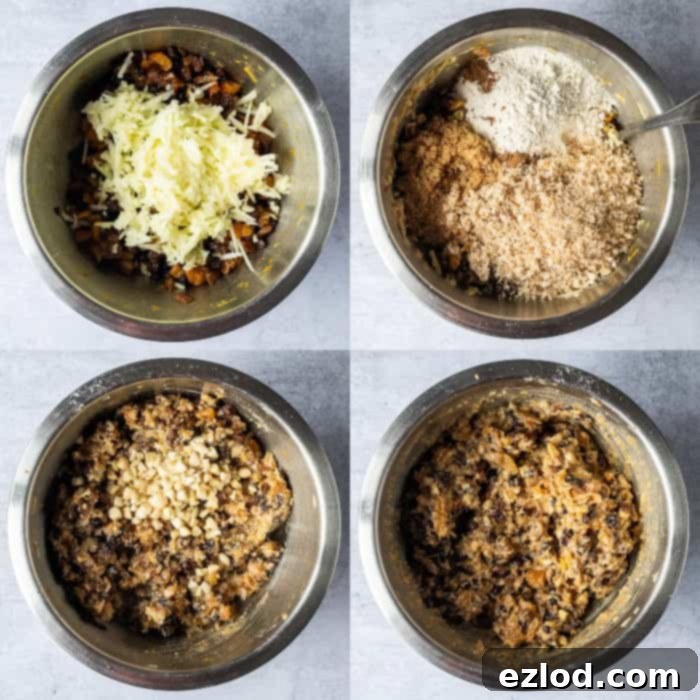
Pudding Basin Preparation & Steaming Setup
Proper preparation of your pudding basin is crucial to prevent sticking. Grease a 1.2-1.4 litre basin thoroughly and place a disc of baking parchment at the bottom. Firmly pack the pudding mixture into the basin, leaving at least a centimeter gap at the top as the pudding will not rise significantly. Creating a secure lid with baking parchment and foil, tied tightly with string, is essential to keep water out during steaming.
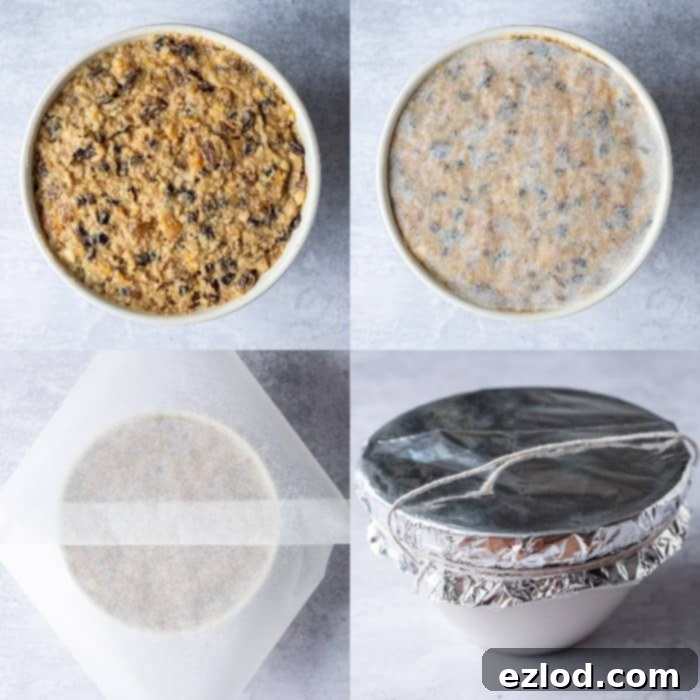
The Steaming Process Explained
Steaming is the traditional and best method for cooking Christmas pudding. Place an inverted saucer at the bottom of a large saucepan to act as a trivet, preventing the basin from direct contact with the pan. Add boiling water until it reaches about halfway up the pudding basin, ensuring it doesn’t touch the foil lid. Cover the pan and simmer gently for five hours. Resist the urge to lift the lid too often, as this releases steam and prolongs cooking. Check the water level periodically and top up with more boiling water if needed.
A perfectly cooked pudding will be a deep brown color, firm to the touch with a slight bounce, and a skewer inserted into the center should come out clean.
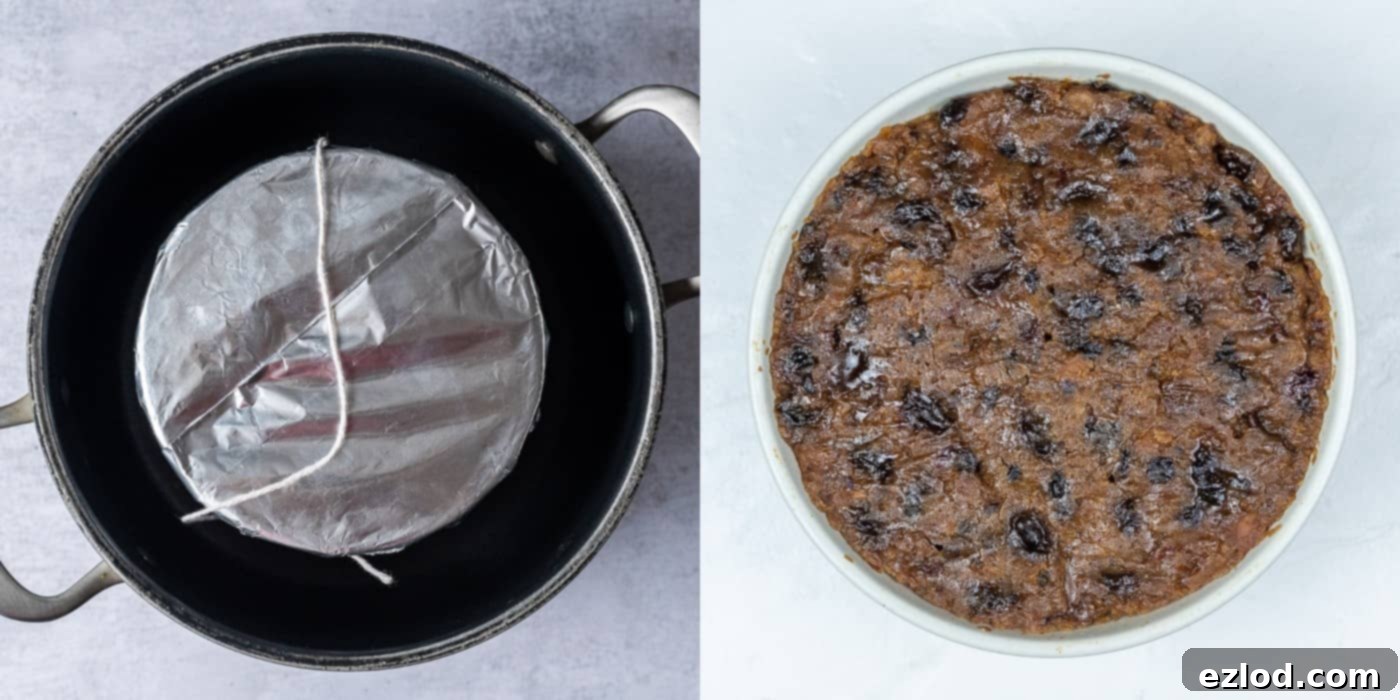
Cooling and Initial Storage
Once steamed, carefully remove the pudding from the pan and let it cool completely. Then, remove the used parchment and foil, replacing them with fresh ones. Your pudding is now ready for storage and maturation or can be served after a final re-steaming on Christmas Day.
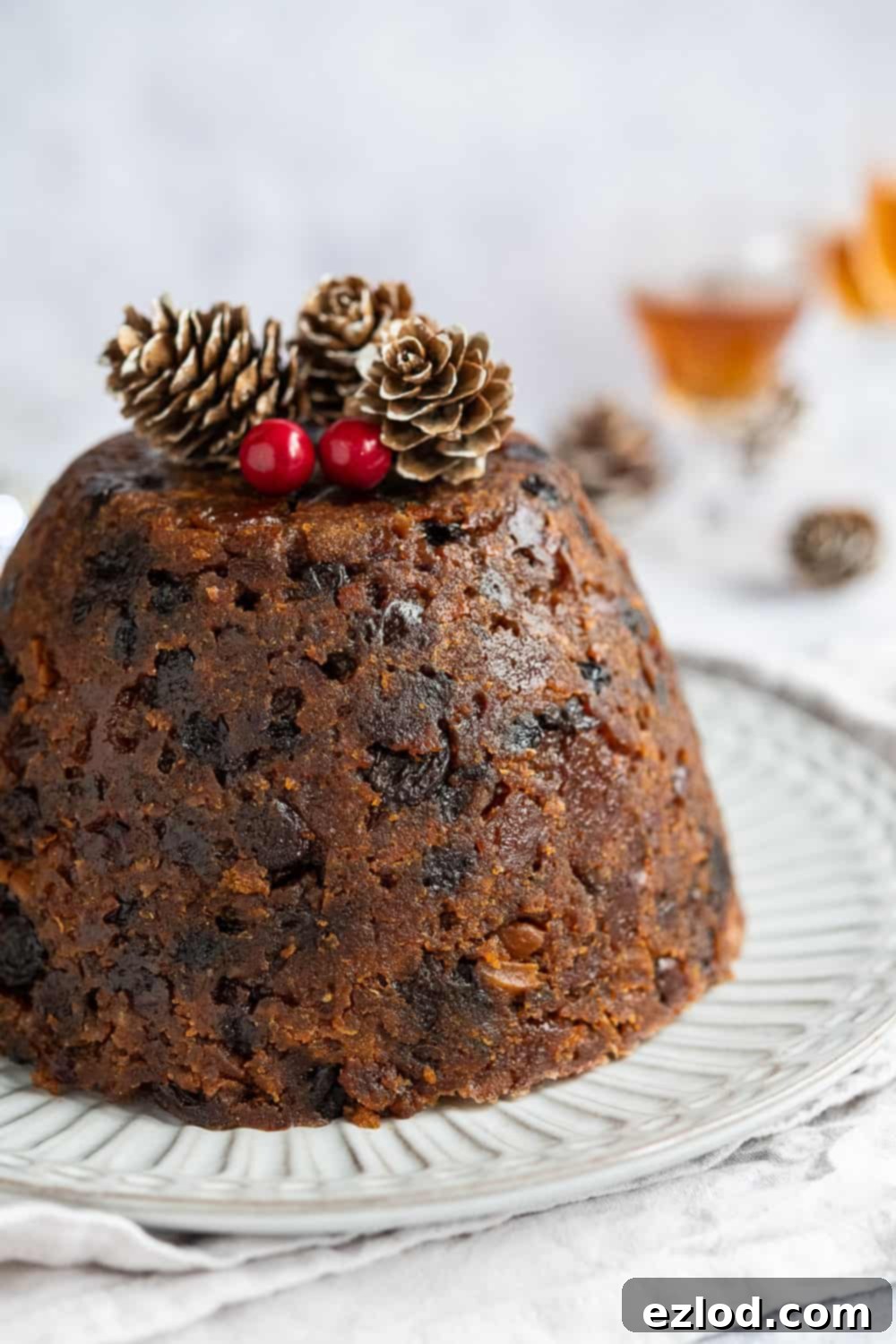
Expert Tips for a Flawless Vegan Christmas Pudding
- Customize Your Dried Fruit: While raisins, currants, dates, and apricots are standard, feel free to experiment with your favorite dried fruits. Dried cranberries, cherries, blueberries, or chopped figs would all work wonderfully. Just ensure the total weight of the dried fruit remains around 450g (16 oz).
- The Significance of Stir-Up Sunday: Traditionally, Christmas puddings are made on ‘Stir-Up Sunday,’ the last Sunday before the season of Advent. It’s a lovely tradition where everyone in the household takes a turn stirring the pudding mix and making a special wish for the year ahead. This tradition highlights the joy of preparing your pudding in advance, allowing it to mature beautifully.
- Fresh Breadcrumbs are Key: This recipe calls for fresh breadcrumbs, not dried. To make them, simply remove the crusts from a couple of slices of slightly stale white bread, weigh out 70g (approx. 2.5 oz), and pulse them in a food processor until finely chopped. This creates a much lighter texture than dried breadcrumbs.
- Gluten-Free Adaptation: For a gluten-free version, swap the self-raising flour for 80g (approx. ⅔ cup) plain gluten-free flour blend, 20g (approx. 2 Tbsp) chickpea (gram) flour, 1 teaspoon gluten-free baking powder, and ½ teaspoon xanthan gum. Replace the fresh breadcrumbs with 70g (approx. ⅔ cup) ground almonds or fresh gluten-free breadcrumbs.
- Leftovers and Freezing: Any leftover Christmas pudding can be stored in an airtight container in the fridge for up to two weeks and reheated as needed. For longer storage, it freezes exceptionally well for up to one year. Ensure it’s well-wrapped to prevent freezer burn, then thaw overnight in the refrigerator before re-steaming.
- Gram Measurements for Baking Success: For the best and most consistent results in baking, always use gram measurements with a digital kitchen scale rather than cup conversions. Cup measurements can be inaccurate and lead to varying outcomes.
Storing and Maturing Your Christmas Pudding
Proper storage is essential, especially if you plan to mature your pudding for several weeks or months. The alcohol plays a vital role in preservation and flavor development.
- Alcoholic Maturation Process: If you’ve made your pudding with alcohol, it can be stored for up to six months. Once it has cooled after its initial steaming, remove the old parchment and foil and replace them with fresh ones. Store the pudding in a cool, dark, and dry place (like a cupboard). To enhance its richness and moisture, ‘feed’ your pudding every one to two weeks by gently removing the foil and parchment, drizzling a tablespoon of brandy or rum over the top, and then re-covering it tightly. The pudding will absorb the alcohol, deepening its flavor and moistness over time.
- Alcohol-Free Storage: If you prefer to make your pudding without alcohol, it will not have the same preservative qualities. In this case, it should be stored in the refrigerator and consumed within two weeks.
- Freezing for Longer Term: For storage beyond six months or if you want to prepare it well in advance, freezing is an excellent option. Ensure the pudding is tightly wrapped in several layers of cling film and then foil to prevent freezer burn. It can be frozen for up to a year. Thaw it overnight in the refrigerator before re-steaming to serve.
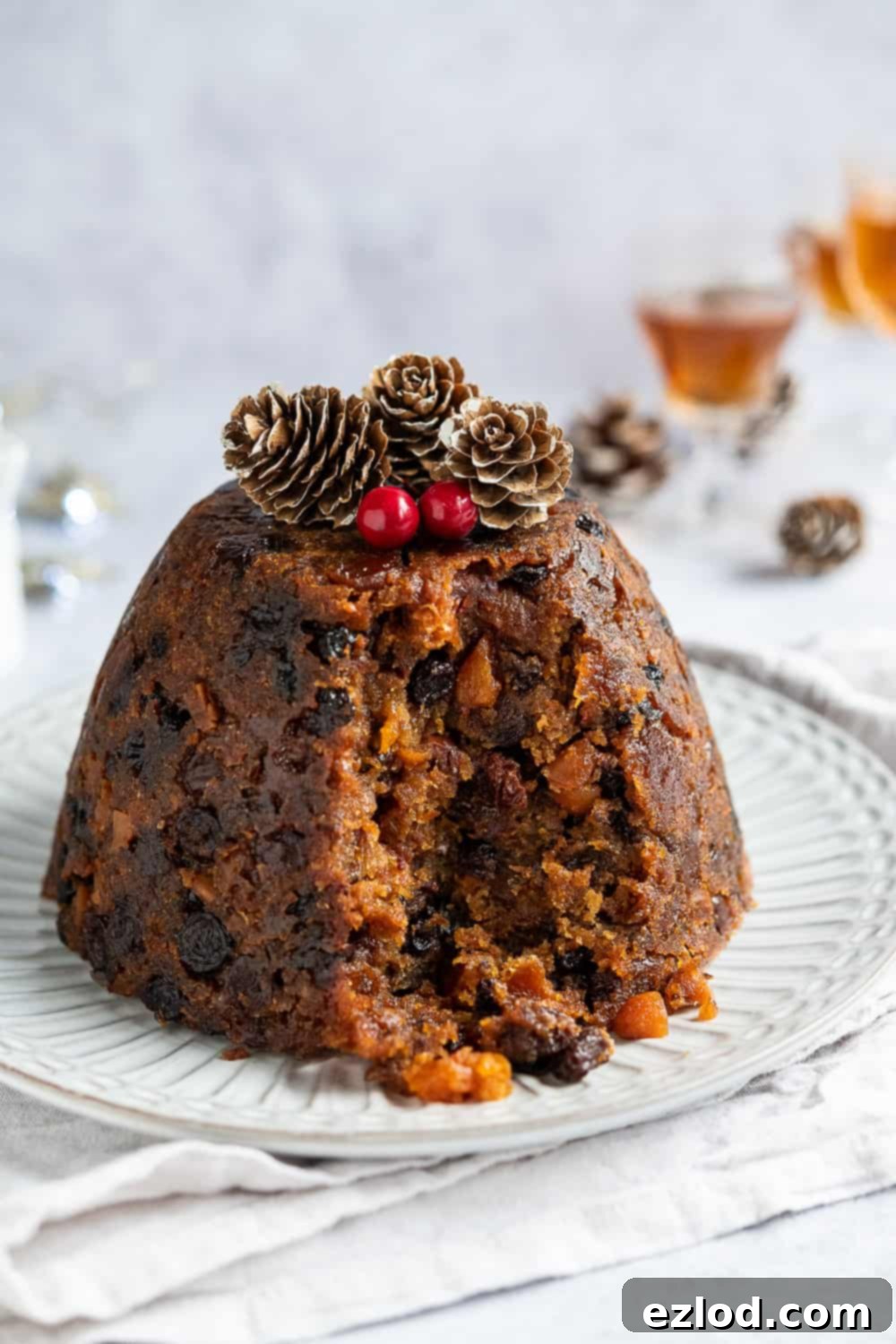
The Dramatic Flair: How to Flame Your Christmas Pudding
For a truly traditional and spectacular Christmas presentation, flaming your pudding with brandy is a custom that adds a touch of magic to the festive table. While entirely optional, it’s a memorable experience!
To light your pudding:
- After its final re-steaming, carefully turn the hot pudding out onto a wide serving plate with a slight lip. The lip is important to contain the flaming alcohol and prevent it from running onto your table.
- Pour about 2-3 tablespoons of brandy, rum, or even vodka into a metal ladle.
- Gently warm the alcohol by holding the bottom of the ladle over a candle, tealight, or a gas hob burner for a few seconds.
- Carefully tilt the ladle slightly sideways so the alcohol catches fire (or use a long match to ignite it).
- Once flaming, gently and slowly pour the burning alcohol evenly over the top of the pudding.
- Immediately dim the lights in the room to allow the beautiful blue flames to be fully admired by everyone! Serve quickly after the flames subside.
Perfect Pairings: What to Serve with Vegan Christmas Pudding
A delicious Christmas pudding deserves equally delicious accompaniments. Traditionally, it’s served with brandy butter or brandy sauce, but many other options complement its rich flavors beautifully.
- Vegan Brandy Sauce: A warm, creamy brandy sauce is the quintessential pairing. To make a simple vegan version, whisk 3 tablespoons of cornflour (cornstarch) into 400ml (1 ¾ cups) non-dairy milk (soy or oat milk works best). Whisk in 75g (⅓ cup) caster sugar, then bring the mixture to a boil, whisking constantly until it thickens. Remove from heat and stir in 3 tablespoons of brandy (or rum), the seeds from one vanilla pod (or 1 teaspoon of vanilla bean paste), and 100ml (⅓ cup + 1 tablespoon) plant-based cream (soy or oat cream are great). Serve warm.
- Vegan Custard: A smooth, warm vegan custard is a comforting alternative, adding a creamy contrast to the pudding’s texture.
- Vegan Ice Cream: For a refreshing twist, a scoop of vanilla vegan ice cream provides a delightful cool counterpoint to the warm pudding.
- Vegan Cream: A dollop of whipped vegan cream (coconut or soy-based) offers a lighter, airy accompaniment.

This vegan Christmas pudding is more than just a dessert; it’s a celebration of flavor, tradition, and the joy of plant-based cooking. Its rich, moist, and boozy character will undoubtedly become a treasured part of your festive feasting for years to come.
More Vegan Christmas Recipes:
- Vegan mince pies
- Vegan Christmas cake
- Vegan mulled wine brownies
- Vegan steamed chocolate pudding
- chocolate gingerbread cookies
- starry mince pie tart
If you tried this recipe why not tag @domestic_gothess on Instagram and hashtag it #domesticgothess
*All images and content on Domestic Gothess are copyright protected. If you want to share this recipe then please do so by using the share buttons provided. Do not screenshot or post the recipe or content in full.*

Print
Vegan Christmas Pudding
Ingredients
- 150 g (5.3oz) raisins
- 100 g (3.5oz) currants
- 100 g (3.5oz) chopped dried dates
- 100 g (3.5oz) chopped dried apricots
- 4 Tbsp brandy/rum/sherry
- finely grated zest and juice of 1 medium orange
- 1 medium cooking apple (about 220g unpeeled weight) (Bramley is best) peeled, cored and grated
- 100 g (¾ cup + 2Tbsp) self-raising flour
- 70 g (1 cup) fresh breadcrumbs*
- 100 g (½ cup + 1 Tbsp) light brown soft sugar
- 1 tsp mixed spice (pumpkin spice)
- 75 g (¼ cup + 2 Tbsp) melted refined coconut oil (or sunflower oil or melted vegan block butter)
- 3 Tbsp aquafaba (the liquid drained from a tin of chickpeas)
- 2 Tbsp non-dairy milk
- 40 g (1.4oz) chopped almonds (optional)
Instructions
-
You need to start making this vegan Christmas pudding the day before you want to steam it as the fruit needs to soak overnight. Mix together the raisins, currants and chopped dried dates and apricots with the rum/brandy/sherry and the orange zest and juice. Cover and leave to soak overnight. I give it a stir every now and again to ensure that the fruit is equally coated.
-
The next day, stir the peeled, cored and grated cooking apple into the fruit mixture.
-
Next, stir in the self-raising flour, fresh breadcrumbs, light brown soft sugar and mixed spice followed by the aquafaba, melted refined coconut oil, non-dairy milk and chopped almonds.
-
Grease a 1.2 – 1.4 litre pudding basin and place a disc of baking parchment in the bottom to prevent the top of the pudding from sticking. Put the kettle on.
-
Spoon the pudding mixture into the greased basin and pack it down firmly then level the top. It is ok if the mixture comes almost all the way up to the top of the basin as it doesn’t rise much but make sure that there is at least a centimetre gap at the top.
-
Make a fold in the middle of a square of baking parchment and the same again in a square of tin foil. Place the baking parchment on top of the pudding basin with the fold in the middle, followed by the tin foil. Press the foil over the edge of the pudding basin.
-
Tie a length of string very tightly around the foil – there should be a lip on the pudding basin; tie the string just under that. Tie a length of string across the top of the basin to make a handle. Trim off the excess foil and parchment, leaving at least a centimeter below the string.
-
Place a saucer upside down in a large saucepan to act as a trivet and place the pudding basin on top. Pour boiling water into the pan so that it comes about halfway up the pudding basin, don’t let it touch the foil.
-
Place the lid on the pan and place over a low heat. Cook at a gentle simmer for five hours (it will do the pudding no harm to leave it to cook for a bit longer than that). Check every now and again to see if the water needs topping up but resist the urge to take the lid off the pan too often.
-
When it is cooked, the pudding should be a deep brown colour and be firm to the touch with a little bit of bounce. A skewer inserted into the centre should come out clean.
-
Once the pudding is done steaming, remove it from the pan and leave it to cool then remove the baking parchment and tin foil and replace them with fresh ones. Store in a cool, dry place for up to six months, feeding it occasionally with rum or brandy.
-
On Christmas day, steam the pudding in the same way for 1-2 hours before serving it. See instructions in the post above for how to flame it.
Notes
- For the best results make sure that you follow the recipe closely and read the post above for all of the tips and information. As always, I highly recommend using the gram measurements (with a digital scale), rather than the cup conversions. Cup measurements are simply not accurate enough for baking and I cannot guarantee the best results if you use them.
- *To make fresh breadcrumbs simply remove the crusts from a couple of slices of slightly stale white bread, weigh out 70g worth and blend them in a food processor until finely chopped.
- You can vary the dried fruit to suit you as long as you keep the same overall weight (450g). Dried cranberries, cherries and blueberries and chopped dried figs would be great options.
- To make this pudding gluten-free, swap the plain flour for 80g plain gluten-free flour blend, 20g chickpea (gram) flour, 1 teaspoon gluten-free baking powder and ½ teaspoon xanthan gum. Swap the breadcrumbs for 70g ground almonds (or fresh gluten-free breadcrumbs).
